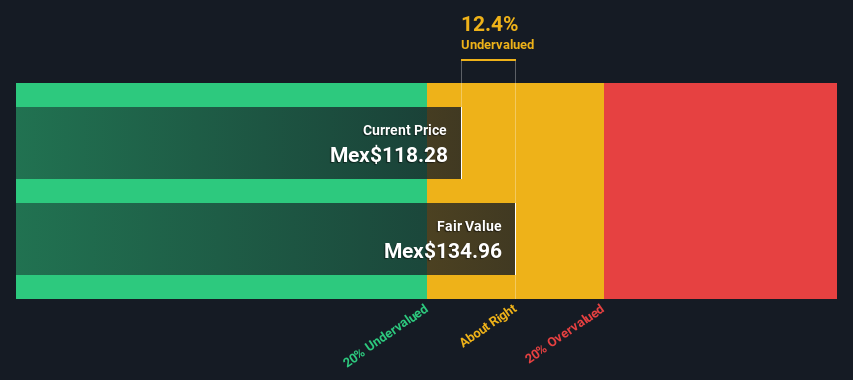- Mexico
- /
- General Merchandise and Department Stores
- /
- BMV:LIVEPOL C-1
Calculating The Intrinsic Value Of El Puerto de Liverpool, S.A.B. de C.V. (BMV:LIVEPOLC-1)

Key Insights
- El Puerto de Liverpool. de's estimated fair value is Mex$135 based on 2 Stage Free Cash Flow to Equity
- With Mex$118 share price, El Puerto de Liverpool. de appears to be trading close to its estimated fair value
- Analyst price target for LIVEPOL C-1 is Mex$124 which is 8.1% below our fair value estimate
Today we will run through one way of estimating the intrinsic value of El Puerto de Liverpool, S.A.B. de C.V. (BMV:LIVEPOLC-1) by projecting its future cash flows and then discounting them to today's value. One way to achieve this is by employing the Discounted Cash Flow (DCF) model. Don't get put off by the jargon, the math behind it is actually quite straightforward.
We would caution that there are many ways of valuing a company and, like the DCF, each technique has advantages and disadvantages in certain scenarios. If you still have some burning questions about this type of valuation, take a look at the Simply Wall St analysis model.
View our latest analysis for El Puerto de Liverpool. de
The Calculation
We use what is known as a 2-stage model, which simply means we have two different periods of growth rates for the company's cash flows. Generally the first stage is higher growth, and the second stage is a lower growth phase. To begin with, we have to get estimates of the next ten years of cash flows. Where possible we use analyst estimates, but when these aren't available we extrapolate the previous free cash flow (FCF) from the last estimate or reported value. We assume companies with shrinking free cash flow will slow their rate of shrinkage, and that companies with growing free cash flow will see their growth rate slow, over this period. We do this to reflect that growth tends to slow more in the early years than it does in later years.
A DCF is all about the idea that a dollar in the future is less valuable than a dollar today, so we need to discount the sum of these future cash flows to arrive at a present value estimate:
10-year free cash flow (FCF) estimate
| 2024 | 2025 | 2026 | 2027 | 2028 | 2029 | 2030 | 2031 | 2032 | 2033 | |
| Levered FCF (MX$, Millions) | Mex$12.2b | Mex$13.9b | Mex$17.6b | Mex$19.8b | Mex$21.8b | Mex$23.9b | Mex$26.0b | Mex$28.2b | Mex$30.5b | Mex$33.0b |
| Growth Rate Estimate Source | Analyst x1 | Analyst x1 | Analyst x1 | Analyst x1 | Est @ 9.99% | Est @ 9.30% | Est @ 8.82% | Est @ 8.48% | Est @ 8.24% | Est @ 8.08% |
| Present Value (MX$, Millions) Discounted @ 17% | Mex$10.5k | Mex$10.2k | Mex$11.1k | Mex$10.8k | Mex$10.2k | Mex$9.5k | Mex$8.9k | Mex$8.3k | Mex$7.7k | Mex$7.1k |
("Est" = FCF growth rate estimated by Simply Wall St)
Present Value of 10-year Cash Flow (PVCF) = Mex$94b
The second stage is also known as Terminal Value, this is the business's cash flow after the first stage. The Gordon Growth formula is used to calculate Terminal Value at a future annual growth rate equal to the 5-year average of the 10-year government bond yield of 7.7%. We discount the terminal cash flows to today's value at a cost of equity of 17%.
Terminal Value (TV)= FCF2033 × (1 + g) ÷ (r – g) = Mex$33b× (1 + 7.7%) ÷ (17%– 7.7%) = Mex$401b
Present Value of Terminal Value (PVTV)= TV / (1 + r)10= Mex$401b÷ ( 1 + 17%)10= Mex$87b
The total value, or equity value, is then the sum of the present value of the future cash flows, which in this case is Mex$181b. To get the intrinsic value per share, we divide this by the total number of shares outstanding. Relative to the current share price of Mex$118, the company appears about fair value at a 12% discount to where the stock price trades currently. Remember though, that this is just an approximate valuation, and like any complex formula - garbage in, garbage out.

The Assumptions
We would point out that the most important inputs to a discounted cash flow are the discount rate and of course the actual cash flows. You don't have to agree with these inputs, I recommend redoing the calculations yourself and playing with them. The DCF also does not consider the possible cyclicality of an industry, or a company's future capital requirements, so it does not give a full picture of a company's potential performance. Given that we are looking at El Puerto de Liverpool. de as potential shareholders, the cost of equity is used as the discount rate, rather than the cost of capital (or weighted average cost of capital, WACC) which accounts for debt. In this calculation we've used 17%, which is based on a levered beta of 1.121. Beta is a measure of a stock's volatility, compared to the market as a whole. We get our beta from the industry average beta of globally comparable companies, with an imposed limit between 0.8 and 2.0, which is a reasonable range for a stable business.
SWOT Analysis for El Puerto de Liverpool. de
- Earnings growth over the past year exceeded the industry.
- Debt is not viewed as a risk.
- Dividends are covered by earnings and cash flows.
- Earnings growth over the past year is below its 5-year average.
- Dividend is low compared to the top 25% of dividend payers in the Multiline Retail market.
- Annual revenue is forecast to grow faster than the Mexican market.
- Current share price is below our estimate of fair value.
- Annual earnings are forecast to grow slower than the Mexican market.
Next Steps:
Valuation is only one side of the coin in terms of building your investment thesis, and it ideally won't be the sole piece of analysis you scrutinize for a company. It's not possible to obtain a foolproof valuation with a DCF model. Instead the best use for a DCF model is to test certain assumptions and theories to see if they would lead to the company being undervalued or overvalued. For instance, if the terminal value growth rate is adjusted slightly, it can dramatically alter the overall result. For El Puerto de Liverpool. de, we've put together three pertinent items you should look at:
- Financial Health: Does LIVEPOL C-1 have a healthy balance sheet? Take a look at our free balance sheet analysis with six simple checks on key factors like leverage and risk.
- Future Earnings: How does LIVEPOL C-1's growth rate compare to its peers and the wider market? Dig deeper into the analyst consensus number for the upcoming years by interacting with our free analyst growth expectation chart.
- Other Solid Businesses: Low debt, high returns on equity and good past performance are fundamental to a strong business. Why not explore our interactive list of stocks with solid business fundamentals to see if there are other companies you may not have considered!
PS. Simply Wall St updates its DCF calculation for every Mexican stock every day, so if you want to find the intrinsic value of any other stock just search here.
Valuation is complex, but we're here to simplify it.
Discover if El Puerto de Liverpool. de might be undervalued or overvalued with our detailed analysis, featuring fair value estimates, potential risks, dividends, insider trades, and its financial condition.
Access Free AnalysisHave feedback on this article? Concerned about the content? Get in touch with us directly. Alternatively, email editorial-team (at) simplywallst.com.
This article by Simply Wall St is general in nature. We provide commentary based on historical data and analyst forecasts only using an unbiased methodology and our articles are not intended to be financial advice. It does not constitute a recommendation to buy or sell any stock, and does not take account of your objectives, or your financial situation. We aim to bring you long-term focused analysis driven by fundamental data. Note that our analysis may not factor in the latest price-sensitive company announcements or qualitative material. Simply Wall St has no position in any stocks mentioned.
About BMV:LIVEPOL C-1
El Puerto de Liverpool. de
Operates a chain of department stores primarily in Mexico.
Flawless balance sheet, good value and pays a dividend.
Similar Companies
Market Insights
Community Narratives




